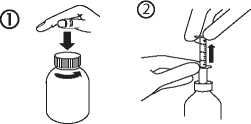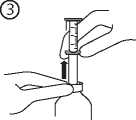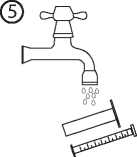Galantamine 4Mg/Ml Oral Solution

Thame Laboratories —
Package leaflet: Information for the user
Galantamine 4mg /ml Oral Solution
(galantamine hydrobromide)

Read all of this leaflet carefully before you start taking this medicine because it contains important information for you.
► Keep this leaflet. You may need to read it again.
► If you have any further questions, ask your doctor or pharmacist.
► This medicine has been prescribed for you only. Do not pass it on to others. It may harm them, even if their signs of illness are the same as yours.
► If you get any side effects, talk to your doctor or pharmacist. This includes any possible side effects not listed in this leaflet. See section 4.
The name of your medicine is Galantamine 4mg/ml Oral Solution but it will be referred to as Galantamine throughout this leaflet.
88Z00 l||S£6SS0||S
What is in this leaflet
1. What Galantamine is and what it is used for
2. What you need to know before you take Galantamine
3. How to take Galantamine
4. Possible side effects
5. How to store Galantamine
6. Contents of the pack and other information
This medicine contains the active substance 'galantamine', an antidementia medicine. It is used in adults to treat the symptoms of mild to moderately severe Alzheimer's disease, a type of dementia that alters brain function.
Alzheimer's disease causes increasing memory loss, confusion and behavioural changes which make it increasingly difficult to carry out normal daily activities.
These effects are thought to be caused by a lack of 'acetylcholine', a substance responsible for sending messages between brain cells. Galantamine increases the amount of acetylcholine in the brain and treats the signs of the disease.
Galantamine should not be used with medicines that work in a similar way, these include:
► donepezil or rivastigmine (for Alzheimer's disease)
► ambenonium, neostigmine or pyridostigmine (for severe muscular weakness)
► pilocarpine (when taken by mouth for dry mouth or dry eyes) if taken by mouth.
Some medicines can make side effects more likely in people taking Galantamine. These include:
► paroxetine or fluoxetine (antidepressants)
► quinidine (for uneven heart beat)
► ketoconazole (an antifungal)
► erythromycin (an antibiotic)
► ritonavir (for human immunodeficiency virus or 'HIV')
► non-steroidal anti-inflammatory painkillers (such as ibuprofen) which can increase the risk of ulcers
► medicines taken for heart conditions or high blood pressure (such as digoxin, amiodarone, atropine, beta-blockers, or calcium channel blocking agents). If you take medicines for an uneven heart-beat, your doctor may check your heart using an electrocardiogram (ECG).
Your doctor may give you a lower dose of Galantamine if you are taking any of these medicines.
Galantamine may affect some anaesthetics. If you are going to have an operation under a general anaesthetic, tell the doctor that you are taking Galantamine, well in advance.
If you have any questions, talk to your doctor or pharmacist for advice.
Pregnancy and breast-feeding
If you are pregnant, think you may be pregnant or are planning to have a baby, ask your doctor or pharmacist for advice before taking this medicine.
You should not breastfeed while you are taking Galantamine.
Driving and using machines
Galantamine may make you feel dizzy or sleepy, especially during the first few weeks of treatment. If Galantamine affects you, do not drive or use any tools or machinery.
Galantamine contains:
Methyl parahydroxybenzoate (E218), which may cause allergic reactions (possibly delayed).
Do not take Galantamine if:
► you are allergic to galantamine or to any of the other ingredients of this medicine (listed in section 6)
► you have severe liver or severe kidney disease.
Warnings and precautions
Talk to your doctor or pharmacist before taking Galantamine. This medicine is only used in Alzheimer's disease and is not recommended for other types of memory loss or confusion.
Serious side effects
Galantamine can cause heart problems and fit (seizures). You must be aware of these side effects while you are taking Galantamine. See 'Look out for serious side effects' in section 4.
Before you take Galantamine, your doctor needs to know if you have, or have had, any of the following
► liver or kidney problems
► a heart condition (such as chest discomfort that is often brought on by physical activity, a heart attack, heart failure, slow or uneven heart beat)
► changes in 'electrolyte' levels (naturally occurring chemicals in the blood such as potassium)
► a peptic (stomach) ulcer
► blockage of the stomach or intestine
► a disorder of the nervous system (such as epilepsy or Parkinson's disease)
► a respiratory disease or infection that affects breathing (such as asthma, obstructive pulmonary disease, or pneumonia)
► problems passing urine.
Your doctor will decide if Galantamine is suitable for you, or if the dose needs to be changed.
Also tell your doctor if you recently had an operation on the stomach, intestines or bladder. Your doctor may decide that Galantamine is not suitable for you.
Galantamine can cause weight loss. Your doctor will check your weight regularly while you are taking Galantamine.
Children and adolescents
Galantamine is not recommended for children and adolescents.
Other medicines and Galantamine
Tell your doctor or pharmacist if you are taking, have recently taken or might take any other medicines.
Always take this medicine exactly as your doctor or pharmacist has told you. Check with your doctor or pharmacist if you are not sure.
How much to take
You will start treatment with Galantamine at a low dose. The usual starting dose is 4mg (1ml of solution), taken twice a day (a total of 8mg a day). Your doctor may gradually increase your dose, every 4 weeks or more, until you reach a dose that is suitable for you.
The maximum dose is 12mg (3ml of solution), taken twice a day (a total of 24mg a day).
Your doctor will explain what dose to start with and when the dose should be increased. If you are not sure what to do, or find the effect of Galantamine is too strong or too weak, talk to your doctor or pharmacist.
Your doctor will need to see you regularly, to check that this medicine is working and to discuss how you are feeling.
If you have liver and kidney problems, your doctor may give you a reduced dose of Galantamine, or may decide this medicine is not suitable for you.
How to take:
This medicinal product must be taken orally.
The solution comes with a pipette which you should use to take the exact amount needed from the bottle.
Take your dose of Galantamine twice a day, in the morning and evening, with water or other liquids. Try to take Galantamine with food.
Drink plenty of liquids while you are taking Galantamine, to keep yourself hydrated.
Directions for opening the bottle and using the pipette
a) Open the bottle: press the cap and turn it anticlockwise (Figure 1).
b) Insert the pipette into the bottle and pull the piston upward to the graduation mark corresponding to the quantity in millilitres (ml) prescribed by your doctor (Figure 2).
5"055935"1 00788
PIL/UK/MFG131/01/v1
TURN OVER


4. Possible side effects
PIL/UK/MFG131/01/v1
5. How to store Galantamine
6. Contents of the pack and other information
POM
5
c) Remove the pipette from the bottle (Figure 3). Empty the pipette into any non-alcoholic drink by pushing the piston to the bottom of the pipette and drink it immediately (figure 4).

d) Wash the pipette with water and store in a clean place (Figure 5).

If you take more Galantamine than you should
If you take too much Galantamine, contact your doctor or hospital straight away. Take any remaining solution and the packaging with you. The signs of overdose may include:
► severe nausea and vomiting
► weak muscle, slow heart beat, fits (seizures) and loss of consciousness.
If you forget to take Galantamine
If you forget to take one dose, miss out the forgotten dose completely and take the next dose at the normal time. Do not take a double dose to make up for a forgotten dose.
If you forget to take more than one dose, you should contact your doctor.
If you stop taking Galantamine
Check with your doctor before you stop taking Galantamine. It is important to continue taking this medicine to treat your condition.
If you have any further questions on the use of this medicine, ask your doctor or pharmacist.
Like all medicines, this medicine can cause side effects, although not everybody gets them.
Look out for serious side effects
Stop taking Galantamine and see a doctor immediately if you notice any of the following:
► Skin reactions, including:
• Severe rash with blisters and peeling skin, particularly around the mouth, nose, eyes and genitals (Stevens-Johnson syndrome).
• Red rash covered with small pus-filled bumps that can spread over the body, sometimes with a fever (acute generalized exanthematous pustulosis).
• Rash that may blister, with spots that look like small targets.
These skin reactions are rare in people taking galantamine (may affect up to 1 in 1,000 people).
► Heart problems including changes in heart beat (such as a slow beat, extra beats) or palpitations (heart beat feels fast or uneven). Heart problems may show as an abnormal tracing on an electrocardiogram (ECG), and can be common in people taking Galantamine (may affect up to 1 in 10 people)
► Fits (Seizures) These are uncommon in people taking Galantamine (may affect up to 1 in 100 people).
Other side effects include:
Very Common side effects (may affects up to 1 in 10
people):
► Nausea and vomiting. These side effects are more likely to happen in the first few weeks of treatment or when the dose is increased. They tend to disappear gradually as the body gets used to the medicine and generally only last for a few days. If you have these effects, your doctor may recommend that you drink more liquids and, may prescribe a medicine to stop you being sick.
Common side effects (may affect more than 1 in 10
people):
► decrease appetite; weight loss
► seeing, feeling, or hearing things that are not there (Hallucinations)
► depression
► feeling dizzy or fainting
► muscle tremors or spasms
► headache
► feeling very tired, weak or generally unwell
► feeling very sleepy with low energy
► high blood pressure
► stomach pain or discomfort
► diarrhoea
► indigestion
► falls
► wounds.
Uncommon side effects (may affect up to 1 in 100 people):
► allergic reaction
► not enough water in the body (dehydration)
► tingling or numb feeling of the skin (pins and needles)
► change in sense of taste
► daytime sleepiness
► blurred vision
► ringing in the ear that does not go away (tinnitus)
► low blood pressure
► flushing
► feeling the need to vomit (retch)
► excessive sweating
► weak muscle
► increased level of liver enzymes.
Rare side effects (may affect up to 1 in 1,000 people):
► inflammation in liver (hepatitis).
Reporting of side effects:
If you get any side effects, talk to your doctor or pharmacist. This includes any possible side effects not listed in this leaflet. You can also report side effects directly via the Yellow Card Scheme at www.mhra.gov.uk/yellowcard.
By reporting side effects you can help provide more information on the safety of this medicine.
► Keep this medicine out of the sight and reach of children.
► Do not use this medicine after the expiry date which is stated on the carton or bottle label after 'Exp'.
The expiry date refers to the last day of that month.
► This medicinal product does not require any special temperature storage conditions. Store in the original bottle in order to protect from light.
► Discard 90 days after first opening.
► Do not use this medicine if you notice that the solution becomes discoloured or shows any signs of deterioration. Seek the advice of your pharmacist.
► Do not throw away any medicine via waste water or household waste. Ask your pharmacist how to dispose of medicines you no longer use. These measures will help to protect the environment.
What Galantamine contains:
Each ml of oral solution contains 4 mg galantamine (as hydrobromide).
The other ingredients are methyl parahydroxybenzoate (E218), sodium hydroxide (E524), saccharin sodium (E954) and purified water.
What Galantamine looks like and contents of the pack
Galantamine is a clear, colourless oral solution supplied in an amber glass bottle with tamper-evident child resistant plastic cap and a pipette for measuring a dose.
Galantamine is supplied in bottles containing 100ml solution.
Marketing Authorisation Holder and Manufacturer:
Thame Laboratories, Unit 4, Bradfield Road, Ruislip, Middlesex,
HA4 0NU, UK
This leaflet was last revised in 09/2016.
This medicinal product is authorised in the Member States of the EEA under the following names:
UK and MT: Galantamine 4mg/ml Oral Solution
055935
100788